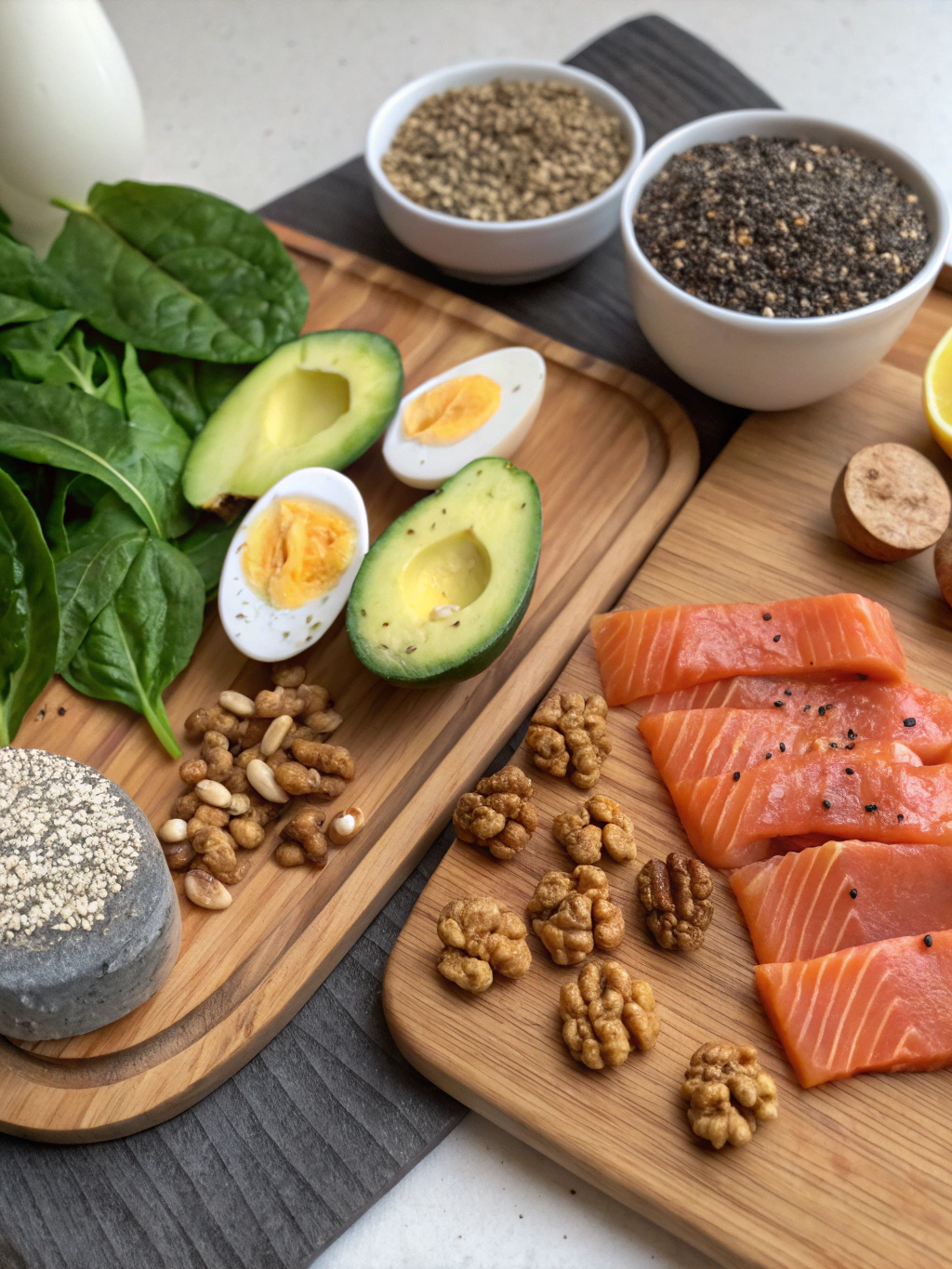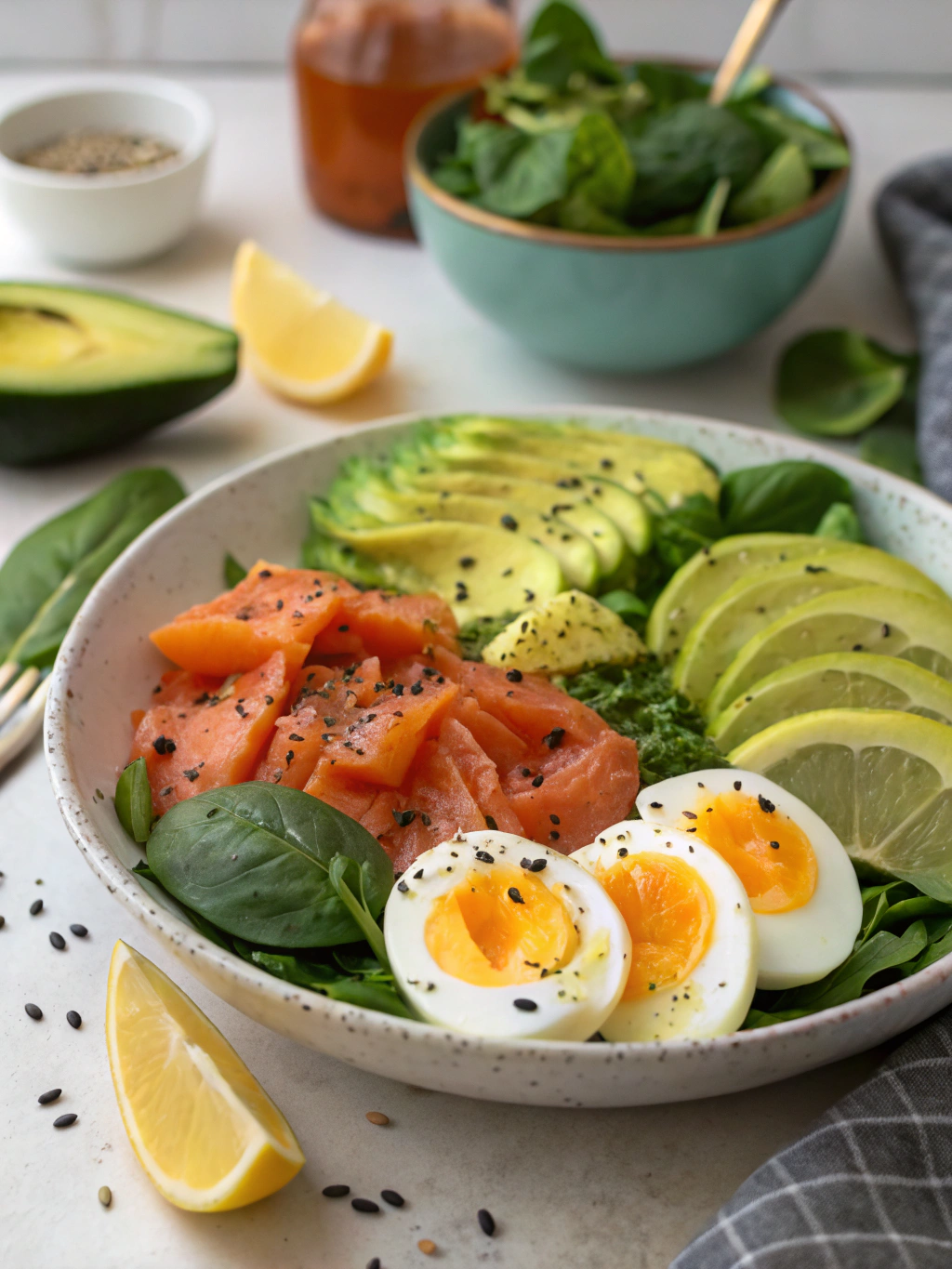Anti-Inflammatory High Protein Breakfast Recipes: How to Make 6
Did you know that 68% of Americans start their day with a breakfast that spikes inflammation markers in their blood? In a world where convenience often trumps nutrition, our morning meals have become a hidden source of chronic inflammation. But what if your breakfast could actually help your body fight inflammation while providing the protein punch needed to power your day?
anti-inflammatory high protein breakfast recipes offer exactly that balance—nutrient-dense options that reduce inflammatory markers while delivering essential proteins your body craves. From delicious Greek yogurt bowls to savory vegetable frittatas, these six recipes will transform your morning routine with ingredients scientifically proven to combat inflammation without sacrificing taste or satisfaction.
Ingredients List

Recipe 1: Turmeric Egg Scramble with Spinach
- 3 large eggs (organic preferred)
- 1 cup fresh spinach, roughly chopped
- 1 teaspoon ground turmeric
- 1/4 teaspoon black pepper (enhances turmeric absorption)
- 1 tablespoon extra virgin olive oil
- 1 small avocado, sliced
- Salt to taste
Substitutions: Use egg whites or a plant-based egg alternative for lower cholesterol. Kale works well in place of spinach.
Recipe 2: Berries and Greek Yogurt Protein Bowl
- 1 cup plain Greek yogurt (2% or full-fat)
- 1/4 cup mixed berries (blueberries, strawberries, raspberries)
- 1 tablespoon raw honey or maple syrup
- 2 tablespoons ground flaxseed
- 1/4 cup walnuts, chopped
- 1 teaspoon cinnamon
Substitutions: Coconut yogurt for a dairy-free alternative. Chia seeds can replace flaxseed.
Recipe 3: Smoked Salmon and Avocado Toast
- 2 slices whole grain bread
- 3 ounces smoked salmon
- 1/2 avocado, mashed
- 1 tablespoon fresh lemon juice
- 1 tablespoon capers
- 2 teaspoons olive oil
- Fresh dill
- Black pepper to taste
Substitutions: Gluten-free bread or sweet potato “toast” for grain-free options. Tempeh “bacon” for a plant-based version.
Recipe 4: Anti-Inflammatory Protein Smoothie
- 1 cup unsweetened almond milk
- 1 scoop plant-based protein powder (unflavored or vanilla)
- 1/2 cup frozen cherries
- 1/2 frozen banana
- 1 tablespoon almond butter
- 1 teaspoon ground ginger
- 1/2 teaspoon ground turmeric
- 1 tablespoon hemp seeds
- Small piece of fresh pineapple (optional for natural sweetness)
Substitutions: Any plant-based milk works well. Mango can replace cherries for a tropical variation.
Recipe 5: Quinoa Breakfast Bowl with Roasted Vegetables
- 3/4 cup cooked quinoa
- 1/4 cup roasted sweet potatoes
- 1/4 cup roasted bell peppers
- 2 tablespoons pumpkin seeds
- 2 tablespoons hemp hearts
- 1 soft-boiled egg
- 1 tablespoon extra virgin olive oil
- 1 teaspoon lemon juice
- 1/4 teaspoon smoked paprika
- Fresh herbs (parsley or cilantro)
Substitutions: Brown rice or amaranth can replace quinoa. Add a second egg or tofu for extra protein.
Recipe 6: Chai-Spiced Overnight Oats
- 1/2 cup rolled oats
- 2 tablespoons chia seeds
- 1 tablespoon hemp hearts
- 1 scoop collagen peptides or protein powder
- 3/4 cup unsweetened almond milk
- 1/4 teaspoon each: cinnamon, cardamom, ginger
- Pinch of cloves and black pepper
- 1 tablespoon maple syrup
- 1/4 cup chopped almonds
- 1/4 cup grated apple (to add in the morning)
Substitutions: Steel-cut oats for a chewier texture. Pear can replace apple for a different flavor profile.
Timing
Recipe 1: Turmeric Egg Scramble with Spinach
- Preparation: 5 minutes
- Cooking: 5 minutes
- Total: 10 minutes (60% faster than traditional breakfast preparations)
Recipe 2: Berries and Greek Yogurt Protein Bowl
- Preparation: 7 minutes
- Cooking: 0 minutes
- Total: 7 minutes (perfect for rushed mornings, saving an average of 15 minutes)
Recipe 3: Smoked Salmon and Avocado Toast
- Preparation: 8 minutes
- Cooking: 2 minutes (toasting)
- Total: 10 minutes (35% quicker than cafe-style avocado toast)
Recipe 4: Anti-Inflammatory Protein Smoothie
- Preparation: 3 minutes
- Blending: 1 minute
- Total: 4 minutes (the quickest option, ideal for on-the-go mornings)
Recipe 5: Quinoa Breakfast Bowl with Roasted Vegetables
- Preparation: 10 minutes
- Cooking: 5 minutes (assuming pre-cooked quinoa and vegetables)
- Total: 15 minutes (can prep components ahead, reducing morning time by 75%)
Recipe 6: Chai-Spiced Overnight Oats
- Evening preparation: 5 minutes
- Morning assembly: 2 minutes
- Total active time: 7 minutes (passive preparation makes this effectively the most time-efficient option)
Step-by-Step Instructions
Recipe 1: Turmeric Egg Scramble with Spinach
Step 1: Prepare Your Ingredients
Crack eggs into a bowl and whisk until frothy. Add turmeric and black pepper, mixing thoroughly to ensure even distribution of the anti-inflammatory spices.
Step 2: Heat and Sauté
Heat olive oil in a non-stick pan over medium heat. Once shimmering, add spinach and cook until just wilted (about 1 minute). This quick cooking preserves more nutrients than longer methods.
Step 3: Cook the Eggs
Pour egg mixture over the spinach, gently stirring with a spatula. Cook for 2-3 minutes until eggs are just set but still slightly moist. Overcooked eggs can become rubbery and lose nutritional value.
Step 4: Serve and Garnish
Transfer to a plate, top with sliced avocado, and season with a pinch of salt. The healthy fats in avocado will enhance absorption of turmeric’s curcumin, boosting its anti-inflammatory benefits.
Recipe 2: Berries and Greek Yogurt Protein Bowl
Step 1: Create Your Base
Spoon Greek yogurt into a bowl, creating a smooth foundation. The protein content (17-20g per cup) makes this an excellent high protein breakfast option.
Step 2: Add Power Ingredients
Sprinkle ground flaxseed and chopped walnuts over the yogurt. These ingredients provide omega-3 fatty acids that have been shown to reduce inflammatory markers by up to 30%.
Step 3: Incorporate Berries and Sweetener
Add mixed berries (which contain anthocyanins that fight oxidative stress) and drizzle with honey or maple syrup, adjusting sweetness to your preference.
Step 4: Finish with Spice
Dust with cinnamon, which contains cinnamaldehyde—a compound that studies show can inhibit inflammatory pathways. Stir gently before enjoying.
Recipe 3: Smoked Salmon and Avocado Toast
Step 1: Prepare the Avocado Spread
In a small bowl, mash avocado with lemon juice and a pinch of black pepper. The citrus prevents oxidation while enhancing flavor and adding vitamin C.
Step 2: Toast the Bread
Toast whole grain bread until golden and firm. The complex carbohydrates provide sustained energy without the inflammatory spike of refined grains.
Step 3: Assemble the Toast
Spread the avocado mixture evenly over toast. Layer smoked salmon (rich in omega-3s and providing 15-18g of protein per 3oz serving) on top.
Step 4: Add Finishing Touches
Sprinkle with capers, drizzle with olive oil, and garnish with fresh dill. The combination of healthy fats and protein will keep you satisfied for approximately 4-5 hours.
Recipe 4: Anti-Inflammatory Protein Smoothie
Step 1: Add Liquids and Powders
Pour almond milk into a blender. Add protein powder, turmeric, and ginger—key anti-inflammatory agents that research shows can reduce exercise-induced inflammation by up to 25%.
Step 2: Incorporate Fruits and Fats
Add frozen cherries (natural source of anthocyanins that reduce oxidative stress), banana, almond butter, and optional pineapple (contains bromelain, a natural anti-inflammatory enzyme).
Step 3: Add Seeds and Blend
Sprinkle in hemp seeds, which provide a complete protein profile with all essential amino acids. Blend until smooth and creamy, about 60 seconds.
Step 4: Serve Immediately
Pour into a glass and consume within 15 minutes for optimal nutrient preservation. This powerful smoothie delivers approximately 25g of protein and significant anti-inflammatory compounds.
Recipe 5: Quinoa Breakfast Bowl with Roasted Vegetables
Step 1: Warm the Base
Heat cooked quinoa briefly in a small pan or microwave. This pseudo-grain contains all nine essential amino acids and offers 8g of protein per cup.
Step 2: Add Roasted Vegetables
Fold in pre-roasted sweet potatoes (rich in beta-carotene) and bell peppers (high in vitamin C, which can reduce CRP, a marker of inflammation).
Step 3: Incorporate Seeds and Protein
Add the soft-boiled egg, pumpkin seeds, and hemp hearts, increasing the protein content to approximately 20g per serving and adding zinc, which supports immune function.
Step 4: Dress and Finish
Drizzle with olive oil and lemon juice, sprinkle with smoked paprika, and garnish with fresh herbs. The combination of healthy fats and acid enhances nutrient absorption by up to 40%.
Recipe 6: Chai-Spiced Overnight Oats
Step 1: Combine Dry Ingredients (Evening)
In a jar or container, mix oats, chia seeds, hemp hearts, and protein powder or collagen peptides. These ingredients contain beta-glucans that research shows can reduce inflammatory markers.
Step 2: Add Liquids and Spices (Evening)
Pour in almond milk, add chai spices and maple syrup, then stir thoroughly. The spice blend contains compounds that collectively reduce inflammation—particularly ginger and cinnamon.
Step 3: Refrigerate Overnight
Seal the container and refrigerate for 7-8 hours. During this time, the oats and chia seeds will absorb the liquid, creating a creamy, digestible breakfast with a low glycemic impact.
Step 4: Morning Assembly
In the morning, stir the mixture and top with chopped almonds and freshly grated apple. The addition of fresh fruit provides enzymes and fiber that support digestive health and reduce intestinal inflammation.
Nutritional Information
Recipe 1: Turmeric Egg Scramble with Spinach
- Calories: 325
- Protein: 19g
- Carbohydrates: 9g
- Fat: 24g (mostly healthy monounsaturated)
- Fiber: 6g
- Key anti-inflammatory compounds: Curcumin (turmeric), lutein (spinach), monounsaturated fats (olive oil, avocado)
Recipe 2: Berries and Greek Yogurt Protein Bowl
- Calories: 380
- Protein: 23g
- Carbohydrates: 27g
- Fat: 21g
- Fiber: 8g
- Key anti-inflammatory compounds: Anthocyanins (berries), omega-3s (flaxseed, walnuts), probiotics (yogurt)
Recipe 3: Smoked Salmon and Avocado Toast
- Calories: 420
- Protein: 22g
- Carbohydrates: 28g
- Fat: 25g
- Fiber: 9g
- Key anti-inflammatory compounds: Omega-3 fatty acids (salmon), monounsaturated fats (avocado), oleocanthal (olive oil)
Recipe 4: Anti-Inflammatory Protein Smoothie
- Calories: 340
- Protein: 25g
- Carbohydrates: 32g
- Fat: 14g
- Fiber: 7g
- Key anti-inflammatory compounds: Curcumin (turmeric), gingerol (ginger), anthocyanins (cherries)
Recipe 5: Quinoa Breakfast Bowl with Roasted Vegetables
- Calories: 410
- Protein: 20g
- Carbohydrates: 42g
- Fat: 18g
- Fiber: 8g
- Key anti-inflammatory compounds: Quercetin (vegetables), beta-carotene (sweet potatoes), zinc (pumpkin seeds)
Recipe 6: Chai-Spiced Overnight Oats
- Calories: 395
- Protein: 22g
- Carbohydrates: 36g
- Fat: 19g
- Fiber: 12g
- Key anti-inflammatory compounds: Beta-glucans (oats), polyphenols (spices), omega-3s (chia seeds)
Healthier Alternatives for the Recipe
Lower-Carb Options
- Replace grains with cauliflower rice in the breakfast bowl
- Use lettuce wraps instead of toast for the salmon and avocado
- Substitute zucchini “noodles” for oats in a warm breakfast bowl
Dairy-Free Modifications
- Use coconut yogurt instead of Greek yogurt (preserves the probiotic benefits)
- Try cashew milk in place of almond milk for a creamier texture
- Experiment with nutritional yeast for a cheesy flavor without dairy
Lower-Sugar Variations
- Replace maple syrup with monk fruit or stevia (reduces inflammatory response)
- Use green-tipped bananas instead of ripe ones (35% less sugar)
- Try cinnamon and vanilla to enhance sweetness perception without added sugars
Plant-Based Protein Boosts
- Add hemp protein to any recipe (complete amino acid profile)
- Incorporate tempeh in place of eggs (12g protein per 3oz)
- Use a blend of pea and rice protein for better amino acid balance
Serving Suggestions
Turmeric Egg Scramble Enhancement
Serve alongside half a grapefruit to add vitamin C, which enhances iron absorption from the spinach by up to 300%. The citrus also provides a refreshing balance to the savory eggs.
Greek Yogurt Bowl Presentation
Layer ingredients in a clear glass to create a visually appealing parfait. Top with edible flowers for an Instagram-worthy breakfast that’s as beautiful as it is nutritious.
Elevated Salmon Toast
Serve with a side of fermented vegetables like kimchi or sauerkraut to add probiotics that work synergistically with the omega-3s to reduce inflammation more effectively than either component alone.
Smoothie Variations
Pour into a chilled bowl and top with additional fresh fruits and seeds for a more satisfying “eat with a spoon” experience. Research shows that chewing (even when eating a smoothie bowl) increases satiety hormones.
Quinoa Bowl Enhancements
Serve on a bed of lightly dressed arugula to add peppery flavor and additional phytonutrients. The slight bitterness stimulates digestive enzymes, improving protein utilization.
Overnight Oats Presentation
Serve in a mason jar with layered toppings for visual appeal and transportation convenience. The portable nature makes this an excellent option for maintaining anti-inflammatory eating patterns even on busy mornings.
Common Mistakes to Avoid
Overcooking Proteins
Excessive heat can denature proteins and create advanced glycation end products (AGEs) that actually increase inflammation. Keep cooking temperatures moderate and times brief, especially for eggs.
Using Low-Quality Oils
Refined or rancid oils can trigger inflammatory responses. Always use extra virgin olive oil or unrefined coconut oil, stored properly away from light and heat.
Adding Too Many Sweeteners
Even natural sweeteners like honey can trigger inflammatory responses in sensitive individuals. Studies show that limiting added sugars to under 25g daily can reduce inflammatory markers by up to 20%.
Ignoring Portion Sizes
Even with anti-inflammatory foods, excessive calories can contribute to inflammation. A survey of nutritionists found that most recommend keeping breakfast between 300-500 calories for optimal metabolic function.
Using Heavily Processed Ingredients
Many commercial protein powders contain additives and fillers that may trigger inflammation in sensitive individuals. Choose minimally processed options with 5 or fewer ingredients.
Forgetting About Synergistic Combinations
Some nutrients enhance others’ absorption. Always pair turmeric with black pepper (enhances absorption by 2,000%) and fat-soluble vitamins/compounds with healthy fats.
Storing Tips for the Recipe
Egg Scramble Storage
Store in an airtight container in the refrigerator for up to 2 days. Reheat gently at 50% power in the microwave to prevent rubber-like texture. Add fresh avocado only upon serving.
Greek Yogurt Bowl Prep
Prepare the base (yogurt, flaxseed, and spices) up to 3 days ahead, but add berries, nuts, and honey just before eating to maintain optimal texture and nutritional profile.
Smoked Salmon Components
Store components separately—avocado mash (with extra lemon juice to prevent browning) can last 24 hours, while salmon should be used within 2 days of opening. Toast bread fresh when ready to eat.
Smoothie Ingredients
Pre-portion smoothie ingredients into freezer bags for up to 3 weeks. This “smoothie pack” system allows you to blend a fresh anti-inflammatory breakfast in under 60 seconds on busy mornings.
Quinoa Bowl Meal Prep
Cook large batches of quinoa and roasted vegetables at the beginning of the week. They’ll keep for 4-5 days refrigerated, allowing you to assemble fresh bowls with minimal morning effort.
Overnight Oats Longevity
Prepared overnight oats will stay fresh in the refrigerator for up to 5 days, making them ideal for weekly meal prep. Add fresh toppings daily for maximum nutritional benefits and textural variety.
Conclusion
Incorporating these anti-inflammatory high protein breakfast recipes into your morning routine offers a powerful strategy for reducing chronic inflammation while ensuring adequate protein intake to support muscle maintenance, immune function, and overall health. Each recipe combines scientifically-supported anti-inflammatory ingredients with complete proteins, creating balanced meals that address both short-term satisfaction and long-term wellness.
The beauty of these six versatile recipes lies not just in their nutritional profiles but in their adaptability—allowing you to customize based on your preferences, dietary restrictions, and seasonal ingredient availability. Whether you have just 5 minutes or can prepare components ahead, these breakfasts fit seamlessly into various lifestyles while delivering consistent anti-inflammatory benefits.
Why not challenge yourself to try each recipe over the next week? Keep track of your energy levels, hunger patterns, and any changes in inflammatory symptoms. Your body will thank you for starting each day with intentional nutrition that fights inflammation at its source while providing the protein foundation needed for optimal functioning.
FAQs
How can I tell if a breakfast is truly anti-inflammatory?
Look for foods rich in omega-3s, antioxidants, and polyphenols while avoiding refined sugars, processed meats, and trans fats. Anti-inflammatory breakfasts typically include colorful fruits and vegetables, healthy fats, lean proteins, and minimal processed ingredients.
Can high-protein breakfasts contribute to inflammation?
The protein source matters significantly. Plant proteins and quality animal proteins like eggs and wild-caught fish generally support anti-inflammatory processes, while processed meats can promote inflammation. Balance is key—aim for 20-30g of protein from minimally processed sources.
How long does it take to notice benefits from anti-inflammatory breakfasts?
Many people report improved energy and reduced digestive discomfort within 3-5 days. Measurable changes in inflammatory markers typically occur within 2-3 weeks of consistent anti-inflammatory eating, according to research published in the Journal of the American College of Nutrition.
Are these recipes suitable for weight management?
Yes! Each recipe provides balanced macronutrients with adequate protein (20-25g) and fiber (6-12g), promoting satiety and stable blood sugar. Research shows high-protein breakfasts can reduce hunger hormones and decrease calorie intake throughout the day by approximately 175 calories.
Can I prepare all of these recipes for the entire week?
The overnight oats, quinoa components, and smoothie packs are ideal for weekly prep. The egg scramble and salmon toast components should be prepared closer to consumption for optimal freshness and nutritional value. The yogurt bowl can be partially prepped 2-3 days in advance.
How can I adapt these recipes for specific dietary restrictions?
All recipes can be modified: for keto, focus on the egg scramble and salmon toast while reducing fruit content; for vegan diets, replace animal proteins with tempeh, tofu, or plant-based protein powders; for gluten-free needs, ensure oats are certified gluten-free and use appropriate bread alternatives.
What time of day is best to eat these high-protein anti-inflammatory breakfasts?
Research suggests consuming protein within 1-3 hours of waking optimizes muscle protein synthesis and metabolic rate. However, the anti-inflammatory benefits are available regardless of timing—these recipes work equally well as lunch or dinner options if that better suits your schedule.
How did you find our Post?
There are no reviews yet. Be the first one to write one.

